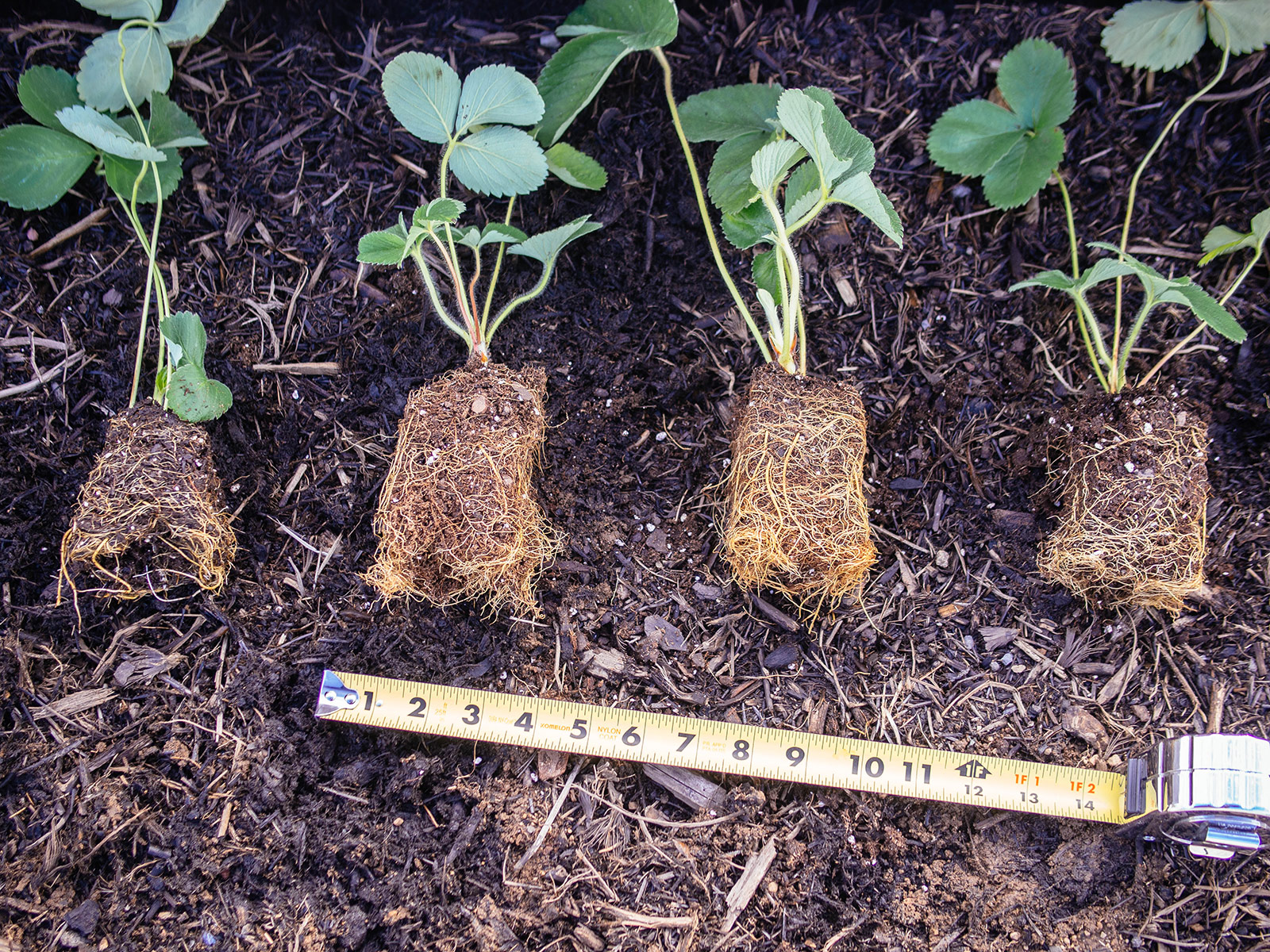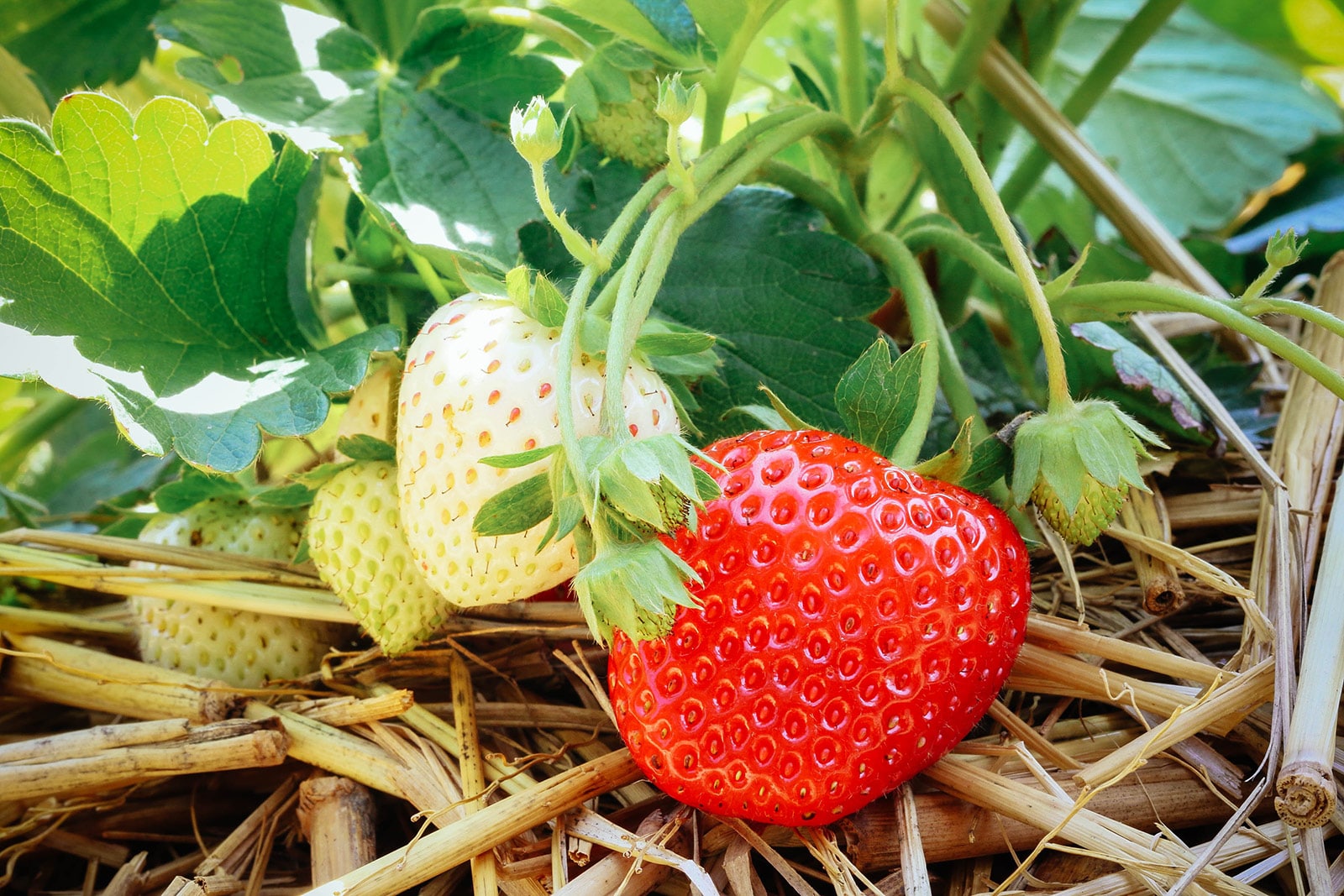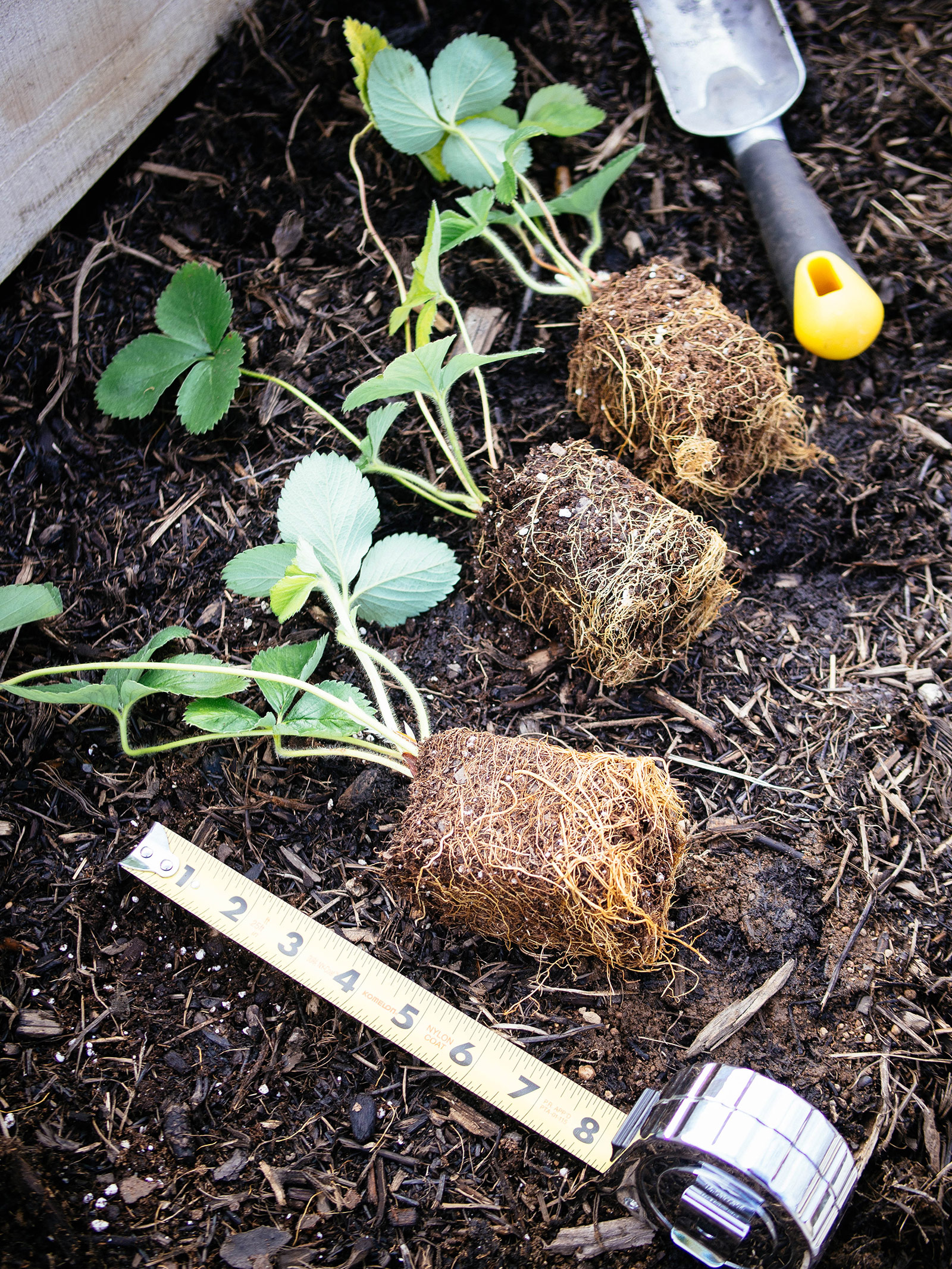So you’ve got your transplants or bare-root strawberries ready to go in the ground, and you’re wondering how far apart to plant them for the biggest, juiciest berries.
The answer will depend on the type of strawberry you’re growing (day-neutral, everbearing, or Junebearing) and what you hope to put into (and get out of) your garden.
I’ve grown all three types of strawberries in the ground, in raised beds, and in strawberry planters, in two totally different climates (Central Oregon zone 6b and Southern California zone 10b). And while the spacing recommendations on your plant labels are a good place to start, they’re not always the best way to go.
Below, I’ll share a few tips and tricks for getting the most out of your strawberry crop by spacing and planting them more efficiently for your particular needs.

What is the best spacing for strawberry plants?
Strawberry plants can be planted as close as 8 inches apart, or up to several feet apart in some cases, depending on the type of strawberry, your garden layout, and your budget.
In general, day-neutral strawberries (including alpine varieties) are planted 10 inches apart, everbearing strawberries are planted 12 inches apart, and Junebearing strawberries are planted 18 inches apart.
These are the minimum recommended spacings for strawberry plants if you want a healthy, productive crop.
| Day-neutral strawberries | 10 inches | 25 cm |
| Everbearing strawberries | 12 inches | 30 cm |
| Junebearing strawberries | 18 inches | 45 cm |
Read more: You can space your plants more closely in a raised bed to get a better harvest—here’s how
But keep reading… There’s more to this depending on your garden goals.

Plant strawberries close together for bigger harvests
If you want to get your strawberry patch going right away, spacing your strawberry plants at a minimum of 8 inches apart will fill in your garden bed quicker. Square-foot gardeners can plant one strawberry plant per square, so that the plants are 12 inches apart.
This tighter spacing of 8 to 12 inches between plants will produce more berries sooner and help keep weeds down. (Granted, you do have to buy or transplant more strawberry plants for this to work.)
The downside to this method is smaller strawberries overall, since the plants will be competing for space and nutrients. So even though you’ll have a bigger harvest, you’ll sacrifice a bit in berry size.
Planting strawberries too close together may also increase the chances of mold or fruit rot, especially in wet or humid climates.

Plant strawberries far apart if you’re on a budget
If you’re on a budget and you’re not in a hurry to get your garden filled out, planting strawberries far apart is a more economical option.
This method works with strawberry plants that produce runners, so the plants propagate themselves without any extra work on your part. They’ll multiply over time and produce baby plants for free, which means you don’t have to buy as many in the beginning.
When you plant strawberries farther apart, you plant them across the entire future strawberry bed, leaving upwards of 2 to 3 feet of space between plants. You’ll have a lot of bare ground and you’ll need to be patient, but your patience will pay off once the runners grow in.
After their first year, most strawberry plants have between three and six baby plants on each of their runners. If left alone, these baby plants will root themselves and mature into adult plants.
But if you want to fill in the empty spaces in your garden bed more effectively, it’s best to move and transplant the babies where you want them.
Once the baby plants are established, the runners dry up and fall off. These new plants will eventually produce their own runners, thus creating even more baby plants—so you can see how it’s pretty simple to let a strawberry patch grow in on its own.

What are strawberry runners?
Most varieties of strawberries send out multiple runners, which are more properly known as stolons. The word “stolon” comes from the Latin word stolo, meaning a shoot or branch springing from the root.
Runners are long, leafless stems that run horizontally above the ground and have baby plants at the ends, which are genetic copies of the mother plant. These tiny clones form adventitious roots (similar to the stems of tomato plants) and grow into the ground surrounding the mother plant, eventually becoming new plants.
Runners are produced by nearly all Junebearing strawberries, and some everbearing and day-neutral strawberries.
Alpine strawberries (a day-neutral type) are a lot less likely to send out runners and tend to grow more crowns right at the base. These crowns can be dug up, divided, and replanted to propagate more plants as needed.

Do strawberries need to be planted in rows or hills?
Unless you’re growing strawberries commercially, there’s no need for formal rows in your garden. By their very nature, strawberries don’t do well contained in rows anyway—they naturally form a tangled patch and are often thought of as ground covers.
Related: These pretty ground covers are resilient enough to be walked on
But if you like a more orderly garden, strawberries are typically planted using one of three planting methods: the hill system, matted-row system, or spaced row system.
Hill system
In this method, “hill” refers to the appearance of the berries—no actual mounding of the soil is required.
With the hill system, plants are set 12 to 15 inches apart in a bed consisting of 3 rows, each of which are also spaced 12 to 15 inches apart. Any runners are cut off as soon as they form.
By not letting new plants develop from runners, the original plants can put all of their energy into producing larger berries.

Everbearing and day-neutral strawberry types are well suited to the hill system since they send out fewer runners, and so less effort is needed to remove runners as they appear.
All the plants in a hill system are treated as perennials and though this method requires more plants initially, it saves on the labor and costs of annual replanting. With proper care, these strawberry plants can produce for five years or more before they need to be replaced.
Matted row system
Junebearing strawberries, with their long and chaotic runners, are best suited to the matted row system.
In this method, plants are set in a row about 18 inches apart, with rows spaced at least 3 feet apart. As the plants grow, they produce runners freely and form new baby plants.
You can guide these runners so they grow closer to adjacent plants, and let them fill in the empty spaces to make a row that’s matted with strawberry plants.

Because the runners are left to grow with wild abandon, strawberry plants are typically treated as biennials in a matted row system. Otherwise, the bed becomes so overcrowded with new plants that crops become smaller and smaller in each subsequent year.
Spaced row system
Personally, I use a variation of the matted-row system (what I call the spaced row system) and find it gives me the biggest, juiciest strawberries without planting new plants every year.
You see, in my experience, removing all the runners and relying solely on the original plants for berries (as you do in the hill system) only works for a couple of years, at best. By that point, the plants start to decline and the size and number of berries drop off sharply.
A better method is to allow runners to develop, but to tame their spread. I do this by thinning out my strawberry plants every 8 to 12 inches (for day-neutral and everbearing types) or every 12 to 15 inches (for Junebearing types) so that the plants still form a mat, but a looser, more controlled one.
Typically I only keep four runners from each mother plant.

This spaced row system allows for better air circulation and more space for plants to grow. Any extraneous runners are removed, but I rely on the runners (and select baby plants) to revive my strawberry patch each year.
(If there’s room in the garden elsewhere, I sometimes even use the extra babies to propagate new plants in other beds or containers.)
Every three years or so, I dig up the oldest (and weakest-producing) plants. (You can tell the oldest ones by their long crowns.) This natural rotation helps new plants thrive in their place and provides a continuous supply of healthy plants—for free!

How far apart do you space strawberry plants in a raised bed?
If you’re wondering how any of those planting methods can work in a raised bed, you should know that I use my hybrid method in a raised bed.
As long as you can comfortably reach the center of your bed from all sides, you can grow your strawberries in the spaced row system that I detailed above.
Start by following my recommended “best practice” spacing for your strawberry plants: 10 inches for day-neutral types, 12 inches for everbearing types, and 18 inches for Junebearing types. Plant them in rows 18 to 24 inches apart in your raised bed.
As the plants send out runners, thin them out to 8 to 12 inches (for day-neutral and everbearing types) or 12 to 15 inches (for Junebearing types). Remove the oldest plants every two to three years.
Over time, your plants will grow less in rows and more in random patterns, and you’ll have a natural, highly productive perennial strawberry bed that regenerates on its own.

Can they be planted too close?
As shown in the matted row illustration above, strawberry plants can definitely end up too close together. When a strawberry patch grows too dense, production eventually suffers—not to mention the risk of diseases goes up considerably.
If you’re growing strawberries for consumption, and not as an edible ground cover or living mulch, it’s important to thin out an overgrown strawberry patch to keep those berries coming.

How many plants do you need per person?
Knowing how many plants to order when you’re planting for more than one person can be tricky. However, here are a few guidelines to help you decide how many strawberry plants you need per person.
First, each strawberry plant typically yields about one quart of strawberries per year. This is true no matter what type of plant you have: Junebearing, everbearing, or day-neutral.
Junebearing types produce one main crop of large berries that amount to at least one quart per plant, if not a bit more under the right conditions.
Everbearing types produce two main crops and a few scattered berries throughout the year. Altogether, you’ll get about one quart of berries from each plant.
Day-neutral types produce scattered berries throughout the growing season, sometimes up to the first frost. While their berries are smaller, they usually produce up to one quart per plant when all is said and done.
For fresh consumption only, I recommend planting 10 to 15 strawberry plants per person. That means 40 to 60 well-cared for strawberry plants will easily feed a family of 4. Voracious strawberry eaters might want at least 15 plants per person, however.
If you want to freeze or dehydrate part of your harvests, aim to grow at least 15 plants per person, at a minimum—though you’ll likely need to plant much more than that (up to 25 plants per person) if you also plan to make jams and jellies.
For my own family (two adults and two kids), I started a new strawberry patch with 100 day-neutral plants. So far that’s been just the right amount for fresh eating, freezing a couple of gallon-sized bags, and making a small batch of strawberry jam.
Remember that older plants start producing fewer and fewer berries after three to four years, and even though they’ll continue growing, they more or less just become ground covers at that point. But if you propagate babies from runners each year, the new plants will make up for that and then some.
More to read: How many plants you need to grow to feed a family
















Great article. Thank you for having written it and putting it out there for us to read. I wish to transplant strawberries into vertical tubes of PVC that I will cut and create little pockets for. Have you any suggestions or experience regarding such a method?
My comment is can you show me what an old strawberry plant looks like. You use the term “high crown”. Someone else told me that it is when the plant looks like a small palm tree. Is that what you mean?
Thank you so much for the great information on planting strawberries! I love getting your emails ❤️
Sincerely, Belinda
Fabric container planters for strawberries? Say I have 10 gallon Root Pouch containers (thank youfor the recommends) How many plants should I plant, how can I keep them going, or do I have to replant every season?
Love your site… Thanks
Buddhahead Steve/Seattle
I recommend day-neutral strawberries for container planting, and they can be planted about 10 inches apart. I don’t know the diameter of the 10-gallon Root Pouches, but I’d guess you could put 2 plants in there (maybe 3, but the closer they are together, the less productive they might be).
Thank you for the numbers and the information. Very helpful!